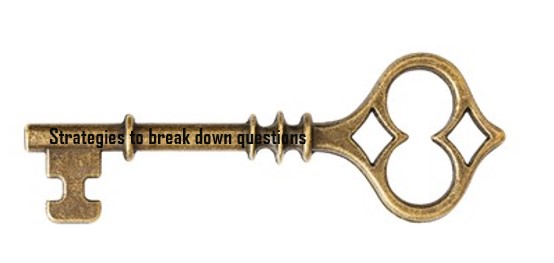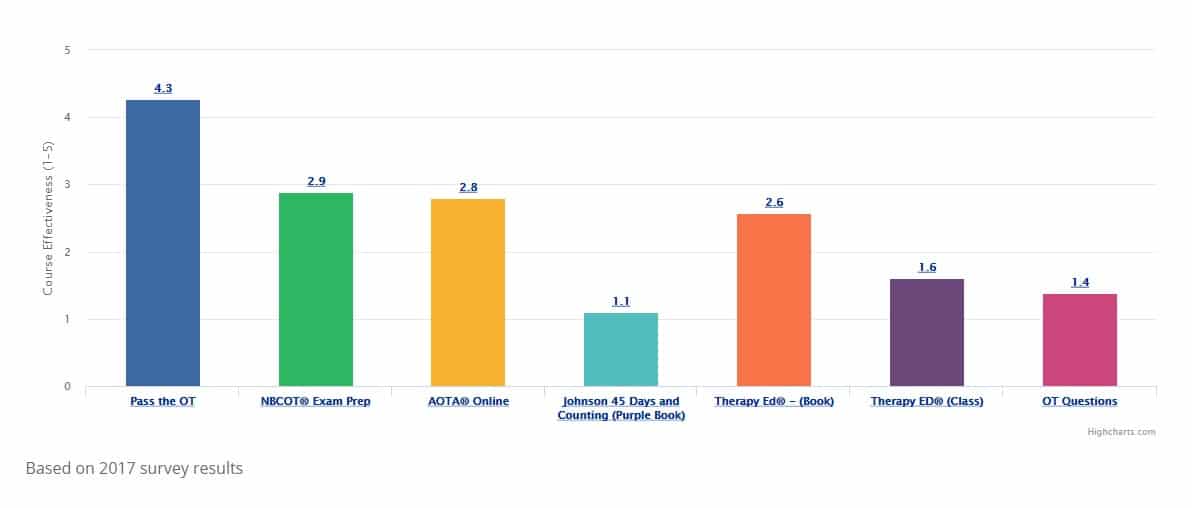
There are 3 key elements to being fully prepared for the NBCOT® exam: 
1. Knowledge
2. Knowing how to break down any question
3. Confidence.
 KNOWLEDGE
KNOWLEDGE
Working your way systematically through the modules in PTOT will help you test your knowledge, learn the material and ultimately master the content you need to know for the exam.
 TIPS TO BREAKING DOWN QUESTIONS
TIPS TO BREAKING DOWN QUESTIONS
a. MAKE SURE YOU UNDERSTAND WHAT THE QUESTION IS ASKING YOU
b. USE A STRATEGY TO HELP YOU FIND THE CORRECT ANSWER
Besides the DOCK and SIMPLE STEPS METHODS, there is also the DASHBOARD METHOD to help you decipher any question.
D A S H B O A R D
DIAGNOSIS – diagnosis/diagnoses
Ask yourself: What can I expect based on the diagnosis/diagnoses?
E.g. TBI – you can expect both physical and cognitive difficulties (personality changes, loss of inhibition, depression, visual perceptual difficulties, mobility issues, difficulty with ADLs)
If there is more than one diagnosis/deficit, your answer should address all diagnoses/deficits.
AGE – age of the patient (baby vs. senior)
Ask yourself: What stage of life is the patient in?
This will help you decide on which approach you should use for this patient.
E.g. A child with CP has the possibility of making progress due to plasticity of the brain. Whereas, an adult with Alzheimer’s disease is not able to make progress in their functional and cognitive abilities.
SETTING – inpatient, outpatient, cardiac rehab unit, psych ward, schools etc…
Ask yourself: Where am I assessing/ treating the patient?
E.g. A patient in an inpatient unit would typically need acute intervention whereas, a patient in an outpatient setting would need long term rehabilitation.
HOW – what are your goals
Ask yourself: How can I help this patient?
E.g. Splinting to reduce spasticity, energy conservation techniques for a patient undergoing cardiac rehab …
BEST CLINICAL JUDGEMENT – using your clinical judgement will help you decide on the best type of intervention
Ask yourself: What is the best intervention for the patient in order to achieve your and their goals?
OT PROCESS – Consultation, screening, evaluation, goal setting, intervention, or discharge
Ask yourself: At what stage is this scenario taking place?
E.g. A screening is not an in depth evaluation, therefore using a standardized assessment is not indicated.
ACTIVE PARTICIPATION – intervention should always be client based.
Ask yourself: What meaningful intervention can I select to ensure that the patient actively participates in the therapy process.
E.g. If it has been identified that the patient enjoys a particular type of activity, then choosing the same type of activity as part of your intervention is likely to entice the patient to be actively involved in their treatment.
READ CAREFULLY – read question and all answer choices
Before answering a question, read through the question carefully – make sure you understand what is being described and what is being asked of you. Read each answer choice to understand what your choices are.
If you are asked for a recommendation then you need to only give a recommendation.
DESCRIPTIVE WORDS – take note of words such as best, most, next…
This is crucial in determining your answer.
E.g. if you are asked for the best, this usually indicates that more than one answer is correct and you need to select the BEST answer.
The Complete Guide to Breaking Down Questions
UNDERSTANDING THE QUESTION |
|
| LOOK AT EACH QUESTION AS A STORY. Summarize what you are being asked in the core question. |
Use your own word to summarize the scenario/story. Do not insert any additional information into the question. – only use the information that is directly provided to you. – don’t add to the story, don’t make things up, and don’t make assumptions.Then: Make clear and concise decisions.YES or NO to each answer choice. |
| IMPORTANT INFORMATION | Type of Setting (acute, inpatient, outpatient, school, etc.) Target Population (babies, adolescent, senior) Diagnosis (new/acute, chronic, progressive, auto-immune, degenerative, mental health) Presented SymptomsPROVIDED (fatigue, weakness, pain, hypersensitivity, decreased ROM.) Patient/Caregiver Goals: patient-centered Direct Quotes: be client-centered |
| WORKING OUT THE CORRECT ANSWER | |
| TIME CONTEXT CLUES Take note of the stage of the OT Process, and the stage of the patient’s diagnoses. I.e. Where you are in the OT Process of : Progressive Disease, Burn Stages/Phases, Splinting, etc. |
OT Process: Evaluation/Intervention Initial/First Next Regular/monthly/periodic Last At Discharge . Stages of Disease/Injuries: Recently Diagnosed At the Beginning/At the start Immediately Following Progressive Diseases: Onset Of Early Stage Middle Stage End Stage Terminal Stage . Surgical Procedures: Pre or Post-Operative/Surgical/Prosthetic Before/After/During Surgeries & Skin Grafts |
| KEY WORDS FOR SEVERITY OF SYMPTOMS | • Minor • Mild • Significant • Substantial • Moderate • Severe |
| ALERT WORDS – “ODD MAN OUT” | Look out for these words: Except Contraindicate At Risk Least Helpful Least Restrictive Environment Least likely to be effective…. |
| ACTION OR ACTIVE WORDS: Keep in mind: The patient is always an Active Participant in their Therapy Intervention. |
The following verbs will give you an idea what therapeutic role you are meant to play, in the session: Implement Demonstrate Train Collaborate Aid, Assist Utilize Facilitate Mentor, Coach Lead Direct Develop Initiate, Introduce Produce, Provide Stimulate |
| WATCH OUT FOR THESE WORDS Answer choices with these words are typically not the right answer choice because OT is not black and white. |
Never Only Must All |
| BEFORE MOVING TO THE NEXT QUESTION | |
| ASK YOURSELF Have you picked the absolute best/most appropriate answer choice that addresses the problem in the question? There is no need to highlight “Best” or “Most” as you should always automatically look for the BEST OPTION. |
Is your answer choice: • SAFE?? – Always Safety First • Ethical? • Client is an ACTIVE PARTICIPANT? • Client/Family Centered? |
| SCOPE Use this CHECKLIST |
S– Safety – Always Safety First – make sure your answer choice SAFE C– Client Centered – The patient/family is an ACTIVE PARTICIPANT O-Occupation Based P– Positive, doing good, beneficial, growth/progress E– Ethical? |
| 2 ANSWERS VERY SIMILAR Answers that are basically the same but have different wording |
. Eliminate BOTH right away. |
| BRAIN FART | |
| JUST DON’T KNOW THE ANSWER | Strategy: • Go with the answer choice with the most words or the longest response. • Recognize patterns in a question/answer: sometimes the correct answer choice reflects the same words to clue you in. • Every 30 Minutes: Rest your eyes. Close your eyes, take deep breaths, stretch for 30 seconds. MARATHON. This comes when you are pacing your timing, one minute per question AVERAGE, some will be shorter some slightly longer. • Respect each question as you encounter it. • DO NOT use the review button at all. • Carefully consider answer choice and be able to rationalize why YOUR answer is correct. • Pull out brain fart strategy and apply if you are taking too long. • Reduce anxiety and move on. • Do not dwell on questions you struggled with!! • Come to peace NOW that you will not know every single answer. • Answer and move on. • It’s over, you will never encounter it again. • Treat each question as an individual patient. |
| MUSCULOSKELETAL/HAND/SPLINT/CARDIO | |
| Be especially careful to consider TIME CONTEXTUAL CLUES | How many days/weeks since initial injury? How many days/weeks since initial Cardiac Event? How many days/weeks since initial burn? Assessment/Intervention based on this info… E.g: Fx in week 2 different than intervention you choose 8-9 weeks post Fx. |
| ALWAYS, ALWAYS, ALWAYS keep in mind any key words in the questions that offer information regarding TIME. | E.g: • # of weeks post-surgery • before/during/after • pre or post • week 2 or week 7 • onset/early/stage/initial/last/etc. |
| SUMMARIZE AND HIGHLIGHT | Highlighting should be limited to 6 or 7 clusters of key words, mostly pertaining to the opening scenario. Summarize the opening scenario USING YOUR HIGHLIGHTED KEY WORDS on your grid paper. Summarize useful feedback after ‘yes’ answers. |
| Pick definite YES ANSWERS | FIRST (they are going to give you feedback if that was the right choice). If it’s NOT: feedback will be provided on how the client responded. THEN: pick your no responses Totally unsure? Can’t use the test taking strategy or educated guess? Pick YES…will give you feedback that will help you answer this section. |
| THE POINT SYSTEM Keep in mind that when answering a question, no points are deducted for an incorrect answer. |
Point-wise, answering incorrectly is the same as not answering, so always pick something (whatever your strategy is). It’s the difference of maybe earning a point vs. definitely not earning a point because you did not answer. Don’t leave any questions unanswered. For both single choice and multiple-choice questions – you earn credit for getting a question correct, and no credit if you get it wrong or don’t answer. In terms of strategy, you can opt to choose “yes” because even if it’s incorrect, you get feedback that might help with answering subsequent questions. To develop a strategy that works for you, practice answering some Scenario set questions. |
 Additional Tips
Additional Tips
Before the test, use your whiteboard to write down the information you may need: Write down any topics that you have memorized that you do not want to forget. You may want to list Rancho Scales, Allen’s Cognitive Levels, pediatric development, etc.
Go with your git instinct: The majority of the time the 1st answer choice that you think is correct, is correct.
Only change your answer if you are 90% sure that you chose the wrong one by accident.
 3. CONFIDENCE
3. CONFIDENCE
To feel confident, you really need to believe in yourself. Triggering the right mindset is key to success. Believing and expecting to do well in the exam will make your experience so much more positive.

Recommended videos: Hosted by our 2 Senior Tutors- Angela & Jessica
• Sunday Sesh-Tackling the Test Group Call with Tutors Angela (M.S. OTR®/L) & Jess (M.S.OTR®/L)
• Sunday Sesh- Addressing Students’ Questions Group Call with Tutors Angela (M.S. OTR®/L) & Jess (M.S. OTR®/L)
• Sunday Sesh: Preparing for the Exam and “Question Autopsy”” Group Call with Tutors Angela (M.S. OTR®/L) & Jess (M.S. OTR®/L)
• Sunday Power Hour Group Call with Tutors Angela (M.S. OTR®/L) and Jess (M.S. OTR®/L)




